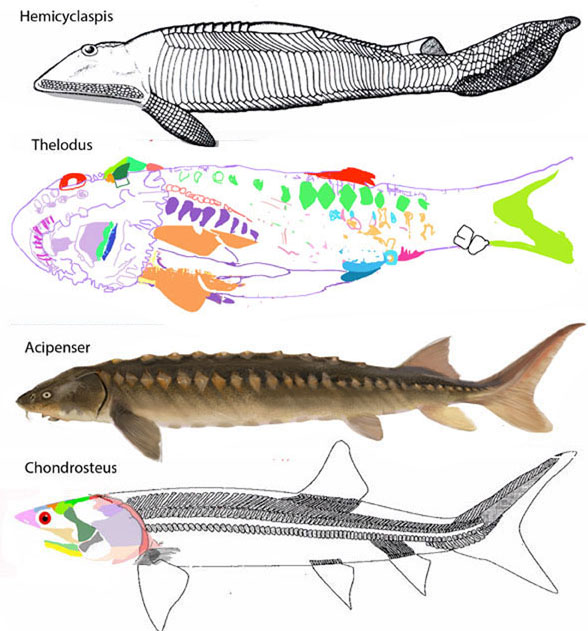Placoderms are different from the rest of us
As we learned earlier, placoderms (Figs 1, 2) developed jaws by convergence (Figs 3, 4) and produced only one extant taxon, Phreatobius, a tiny, semi-terrestrial fish from the Amazon.

Here Eastmanosteus,
(Fig 1) one of the smaller arthrodire (= biting) placoderms, enters the large reptile tree (LRT, 2118 taxa, subset Fig 4) between smaller Coccosteus (Fig 2) and massive Dunkleosteus. The informative diagram provided by Johanson 2003 (Fig 1) informed several changes in tetrapod homology bone identities in placoderms. It’s a great teaching tool that clearly separates the sutures from the sensory canals that cross the bones. Similar facial bones developed independently in the thelodont > sturgeon > shark > bony fish > tetrapod lineage (Fig 3). The lack of a premaxilla, maxilla, lacrimal and squamosal is a common trait in all basal vertebrates.

Eastmanosteus calliapsis enters the LRT today
(Obruchev 1963, originally Dinichthys pustulosus Eastman 1907; Middle Devonian; skull length 27cm, est body length 1.5m. Fig 1). In morphology it closely resembles Coccosteus (Fig 2).

The origin of placoderms
from armored Drepanaspis was recovered by the LRT (Fig 4) recently. The independent origin of jaws in gnathostomes and placoderms was not considered or suggested in prior studies. If so, let me know so I can promote it here.

The Zerina Johanson illustration of Eastmanosteus
(Fig 1) demonstrates the need to rename all basal vertebrate (= fish) facial bones with tetrapod homologs, even if only by color. Otherwise their homology will forever remain in the dark.
Giving credit were credit is due, Zerina Johanson is a placoderm expert.
Her YouTube lecture on Gogo Formation placoderms and lobefins (below) is wonderfully informative, but parts are a little outdated due to taxon exclusion. For instance, as we learned very recently, ptyctodontids are no longer placoderms. Changes like that happen in science when new light is shed on a subject, often by taxon inclusion in the LRT.
References
Eastman CR 1907. NY State Museum Memoir 10: 130.
Hanke GF, Stewart KW and Lammers, GE 1996. Eastmanosteus lundarensis sp. nov. From the Middle Devonian Elm Point and Winnipegosis Formations of Manitoba”. Journal of Vertebrate Paleontology. 16 (4): 606–616. doi:10.1080/02724634.1996.10011351
Johanson Z 2003. Placoderm branchial and hypobranchial muscles and origins in jawed vertebrates. Journal of Vertebrate Paleontology 23, 735–749.
wiki/Eastmanosteus
hwiki/Arthrodira
wiki/Placodermi
reptileevolution.com/dunkleosteus
